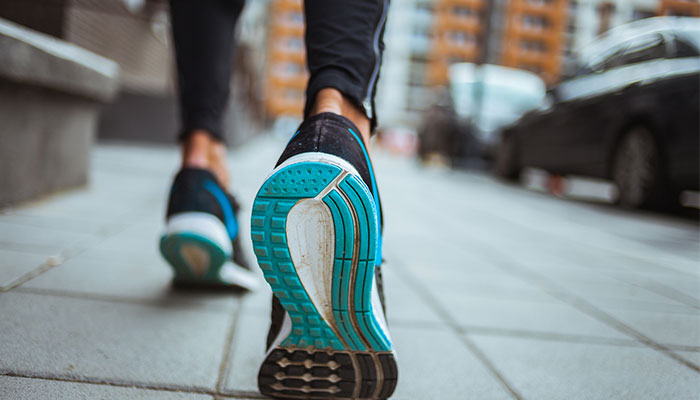At MQ Health’s Physiotherapy Clinic, practitioners are starting to see patients with pain and muscle tension brought about by working from home during the COVID-19 pandemic.
Key problem areas are the neck, shoulders and lower back, says Chris Wynne, Lead Physiotherapist of the clinic’s Outpatient Services. While ill-designed work stations may be a part of the problem, a lack of regular movement and activity is also an important part of the picture.

Get up and go: going straight from bed to your home work space removes the usual incidental morning movement associated with a commute, making a break from home desks even more important, says Wynne.
“It’s from people sitting for really long periods of time and not being quite as active as they normally would be,” says Wynne.
“Part of the issue is people not being in their usual routines; instead of travelling to work, for example, they’re rolling out of bed and getting straight on to a laptop, so there is less of that incidental activity.
“People are still going out and exercising, but they are spending more time being sedentary rather than incidentally moving around.”
Wynne says there is no perfect, one-size-fits-all approach when it comes to setting up a home work station.
“It comes down to finding what works well and what you’re comfortable doing,” he says. “As long as you feel comfortable then your body is ok, and it’s also important to understand that being sore isn’t necessarily a sign that you’ve done damage, or serious harm, or injured yourself.
“We as human beings are far more robust than being able to damage ourselves from sitting for an extended period of time.”
To both avoid and fix work-related pain and soreness, here are some strategies to help.
The best posture is your next posture
Many workers have moved from offices with finely tuned ergonomics where chairs, desks and computers are at perfect heights and positions, to kitchen tables, home studies and other nooks where near enough is as close as we’ll get.

No correct posture: movement is the key regardless of where and how you sit to work from home, says Wynne.
But changing our work set-ups from purpose-built office to re-purposed home equipment is not itself a risk to our health. Rather, spending long periods of time in positions our bodies aren’t used to can cause muscular overload, the common cause of neck pain and muscle tension around the neck and shoulders, Wynne says.
“People ask us, what is the correct posture, and the reality is there is not one correct posture that applies to everyone … our message is that the best posture is your next posture; that movement is really the key here.”
Spending a long period leaning forward over a desk can result in compression and irritation of neck joints, and soreness in muscles as they work hard to keep your head in the forward position. However, says Wynne, it also takes a lot of work to maintain what is considered to be a perfect posture – straight back, head up and shoulders pulled back.
... stand up and move a little, whether it’s jumping five times or marching on the spot for 20 seconds, walking around your desk, arching your back or touching your toes.
“Whether you spend a really long period of time there, or a long period of time slouched over a computer, they’re probably going to have similar effects on muscle pain,” Wynne says.
“I often urge people to think about that ‘perfect posture’ position as a reset, so if you’re getting a bit stiff or a bit tired, you ‘reset’ into that upright, tall posture, just to change the position around.
“Inevitably what we find is that people will keep sinking back into slouch posture any way, over time, so they won’t maintain that upright posture, but it can be a reset.”
Every move counts
Now that you know to reset your posture regularly, always making sure it’s comfortable, Wynne recommends using the reset moment to stand up and move a little, whether it’s jumping five times or marching on the spot for 20 seconds, walking around your desk, arching your back, or touching your toes.
How long between resets depends on people’s tolerance. “Some people can spend two hours in the one spot and be fine, and others will be antsy and wanting to move around after 10 or 15 minutes,” Wynne says.
“It’s very variable and depends on whether you are experiencing symptoms and how comfortable you are, but a rough guideline that seems to work well is to change your position every half hour or so.”

Walk the talk: Wynne says walking around the house while taking work calls is helpful in breaking up long periods of sitting.
Wynne also advises taking breaks away from your desk and walking around the house regularly.
“The other thing that can be helpful is breaking up exercise routines into two smaller sessions in a day, so people are at least getting up and about a bit more.
“Another tactic we recommend is that every time the phone rings, people stand up, walk away from the desk, and walk around while they are taking the call, then sit down again when it’s finished.”
Comfort is king
Working from home can lead to a fixation on having – or lacking – an office chair with all the ergonomic bells, whistles and levers, but, as long as your chair isn’t too high or low in relation to your computer monitor, there is really only one thing that matters.
“It’s not essential to get fixated on the chair; it comes down to a comfort thing more than anything else,” Wynne says.
“The biggest key message is to make sure you’ve got a chair with a good back rest so you can actually relax into it so you’re not using your muscles to sit, but rather the backrest supports you in sitting.
- Please explain: why can you see the sun and the moon at the same time?
- World-first findings pinpoint where and when sharks are more likely to attack
“You can still maintain a really good upright posture by actually letting your hips and your trunk relax and using the backrest to take some of the weight off your body and off your muscles.”
Wynne says people will often find a suitable chair at home.
“If you can’t find a chair around the house that works, then consider what your options are, whether you go and buy a chair, or get one from your office.”
Laptop hack
The ergonomic mantra known by office workers everywhere is that your computer monitor should be roughly an arm’s length away from you, and the top of the monitor should be around about eye level.

Relief: muscle soreness can be allieviated by elevating your laptop, stretching and by using heat and cold packs.
However, for laptop users in particular, this can be trickier than it sounds to achieve.
“If you are trying to do the right thing for your head position and have the monitor at eye level, on a laptop it’s not really feasible to then go and hold your arms up all day – things are going to get overworked and sore – so a separate keyboard is a great idea when it comes to laptops.” Wynne says.
“It means you can elevate the laptop, on a monitor rise or even a stack of books, and your arms won’t have to work as hard to hold their weight up while you’re typing away.
Treat yourself
Heat and cold packs are the go-to home treatments for muscular soreness and tightness.
“These are really good for pain relief. Different people will respond to different things - some will prefer cold packs, others hot packs, which in particular are going to be a bit more pleasant as we come into winter,” Wynne says.
The good news is that any musculoskeletal issues you may experience as a result of working from home are highly unlikely to hang around.
“It would be rare that they would become long-standing problems,” Wynne says.
“It often takes a little bit of time to get used to the new set-up, but once we have a comfortable set-up, it mimics what you would do in an office any way … and making those regular changes in posture and moving frequently and finding comfortable positions, makes working from home all perfectly fine and safe.
“It is also a little bit about your body becoming used to it, and the muscles needed to work in that position becoming stronger and more capable of dealing with what we are asking the body to do.”
If you are concerned about your work set-up, The MQ Health Physiotherapy Clinic at Macquarie University offers face-to-face as well as Telehealth consults. Phone (02) 9812 3850 to make an appointment.



